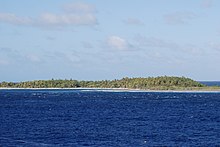Suwarrow
Although Suwarrow was inhabited by Polynesians during prehistory[1] it was uninhabited when discovered by the Russian-American Company ship Suvorov, which reportedly followed clouds of birds to the atoll on 17 September 1814.
In the mid-19th century (records dispute whether it was in 1848 or 1855), a ship from Tahiti was carrying out salvage work when a box containing NZ$15,000 worth of coins was dug up.
[3] John Lavington Evans was the first lessee of Suwarrow, who passes his lease to the Pacific Islands Trading Company Limited.
[4] In 1867, Captain Handley B. Sterndale was engaged by the company and sailed with Evans from Melbourne, Australia to the Cook Islands (then known as the Harvey Group).
[4] In 1876 the atoll was leased to Henderson and Macfarlane of Auckland, which built a wharf, installed a light on a wooden pyramid, and commenced to gather mother of pearl.
[8] In 1964, while Neale was in Rarotonga, June von Donop, a former accountant from Honolulu, Hawaii, lived alone in his house on Suwarrow for a week, while her crewmates on the schooner Europe stayed on board their vessel.
Michael Swift lived alone on Suwarrow in 1965–66, but he was not familiar with survival techniques and had a hard time finding sufficient food.
A proposal to establish an aquaculture operation to farm Tahitian pearls was successfully opposed by Cook Islands environmental NGO, the Taporoporo'anga Ipukarea Society.
[12] Most of the small islets have only herbs and shrubs, with Pemphis acidula and beach heliotrope (Tournefortia argentea) growing in abundance.
At the end of the 20th century, 3% of all red-tailed tropicbirds in the world (some 400) bred there, as well as 9% of the global population of the lesser frigatebird (about 8500, though only a part of these seem to be present at any one time) (Jones 2001).
The atoll has been designated an Important Bird Area (IBA) by BirdLife International because it supports, as well as the tropicbirds and frigatebirds, a large breeding colony of sooty terns, with over 40,000 chicks counted in 2008.
[13] Suwarrow has a rich marine biodiversity, which supports megafauna such as sea turtles, sharks, mantas,[14] and cetaceans including humpback,[15][16] sperm,[17] and false killer whales.


